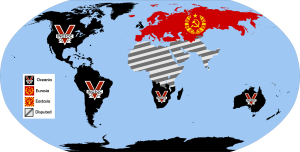Within the few short weeks following the New York Times February 17th Science section revelation that DNA in non-African people comes from Neanderthals, the number of candidates for United States Congress and Senate seats has quintupled. Hundreds of previously contented Cro-Magnon Americans are asserting their Neanderthal ancestry and signing up in droves to run for office. Though the percentage of Neanderthal DNA in the average Cro-Magnon was estimated at one to two percent, scientists admit that the amount may vary widely, reaching “chunks” in descendants from colder climes, particularly Siberia, but extending throughout northern Europe.
In a CNN interview appearing immediately after New York Times subscribers received the news, a leading contender for the country’s highest office said “We are all Neanderthals”, immediately triggering the rush. Within hours, the Federal Election Commission ran out of the necessary forms, leaving potential candidates lined up from the FEC offices on E Street NW all the way to 1600 Pennsylvania Avenue and beyond. Though few in the crowd admitted to being registered Democrats, two did agree that emphasizing their Neanderthal genes could make them more electable. The Republicans have enough Neanderthals already was a sentiment repeated by others in the crowd. Pushing, shoving and some Neanderthal rock-throwing necessitated calling the National Guard to keep order. Banks were besieged by would-be candidates withdrawing an excess of $5,000, the minimum sum required with registration.
Previously, geneticists had believed that humans had split from Neanderthals about 600,000 years ago, but in 2013, research at the Max Planck Institute for Evolutionary Anthropology in Leipzig, Germany, concluded that there is absolute proof of the exchange of DNA between the two populations. They had our genes, and we have theirs. The evidence was replicable and incontrovertible. Neanderthals and Cro-Magnons had interbred, a finding that many Cro-Magnons had found so outrageously incredible and downright repulsive they refused to believe it.
The newest evidence came from a male Neanderthal toe bone discovered in the Altai Mountains of Siberia. Comparing that genome to modern human DNA confirmed the interbreeding. More recently, jumbled DNA from both sources has been discovered, and we now have detailed reconstructions of Chromosome 21, proving that Cro-Magnons and Neanderthals had intimate relationships. This milestone research is credited to the Planck team and verified by Adam Siebel, a geneticist at Cold Spring Harbor Laboratory and co-author of the new study with Bench Viola, a paleontologist at the University of Toronto. We poked and prodded and couldn’t get it to go away, said Siebel and Viola, both aware that finding their Neanderthal ancestors might not thrill everyone on the planet, though they hardly could have expected the astonishing effect of their research on the American electorate. Well, commented a leading Democratic senator, It’s not like discovering you’re related to Leonardo de Vinci or Abraham Lincoln. I’m willing to work with them.
Cro-Magnons had fire and apparently did a bit of cooking. There’s evidence of Cro-Magnon fashion sense in their scraped animal skins, and the fact of armholes and sleeves in their clothing. (They were, after all, in France). Not only that, but they had personal ornaments; mostly rocks, and smaller ones to wear. Stones. Further proof comes from modern descendants who use exactly the same words for their jewelry. The single most striking difference between Neanderthals, Cro-Magnons and homo sapiens remains the larger size of the Neanderthal skull. That discrepancy continues to puzzle the scientists, who have yet to find what filled the extra space.
For deniers of this proven co-mingling of Neanderthals and Cro-Magnons, there should be some (but maybe cold) comfort in those lovely drawings at Lascaux and Chauvin caves in the Dordogne Valley of France and in El Castillo cave in Spain. Less consoling is despite having language, Cro-Magnons seemed to be far more experienced at drawing than public speaking, communicating with strangely grotesque facial contortions, extensive hand gestures and exaggerated shrugs; a persistent Neanderthal mode surviving for 100,000 years. Just 2 percent of those genes might put a Neanderthal finger on that red button. What could a “chunk” of it do?






Be First to Comment